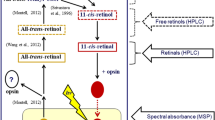Summary
The effect of daylight on the compound eye was investigated in the deep-water crustacean isopod Cirolana borealis Lilljeborg. The animals were captured and fixed at night (‘dark-exposed’, i.e. not exposed to light) and day (‘daylight-exposed’), respectively. Changes in light and darkness have an effect on the retinula cells; the ultrastructure of dark-exposed eyes is characterized by well-preserved organelles and cytoplasm. The photoreceptor membranes covering the microvilli are regularly aligned, and the outline of the villi is smooth. Electron-dense pigment granules are evenly distributed in the cytoplasm of the retinula cell outside the rhabdom. Daylight-exposed eyes differ from the dark-exposed eyes in the following aspects: (i) the microvilli are disrupted, (ii) retinula-cell pigment is found in the rhabdom, and (iii) the cytoplasm of retinula cells is vesiculated. These results are interpreted as retinal damage caused by excess exposure to light.
Similar content being viewed by others
References
Beddard FE (1888) On the minute structure of the eyes in certain Cymothoidae. Trans Roy Soc Edinburgh 33:443–452
Bedini C, Ferrero E, Lanfranchi A (1977) Fine structural changes induced by circadian light-dark cycles in photoreceptors of Dalyelliidae (Turbellaria: Rhabdocoela). J Ultrastruct Res 58:66–77
Behrens M, Krebs W (1976) The effect of light-dark adaptation on the ultrastructure of Limulus lateral eye retinular cells. J Comp Physiol 107:77–96
Blest AD (1978) The rapid synthesis and destruction of photoreceptor membranes by a dinopid spider: a daily cycle. Proc R Soc London B 200:463–483
Carlson S, Gemne G, Robbins W (1969) Ultrastructure of photoreceptor cells in a vitamin A deficient moth (Manduca sexta). Experientia 25:175–177
Eakin RM, Brandenburger JL (1974) Ultrastructural effects of dark-adaptation on eyes of a snail, Helix aspersa (1). J Exp Zool 187:127–133
Edwards AS (1969) The structure of the eye of Ligia oceanica L. Tissue and Cell 1:217–228
Eguchi E, Waterman TH (1966) Fine structure patterns in crustacean rhabdoms. In: Bernhard CG (ed) The functional organization of the compound eye. Pergamon Press, Oxford, pp 105–124
Eguchi E, Waterman TH (1979) Longterm dark-induced fine structural changes in crayfish photoreceptor membrane. J Comp Physiol 131:191–203
Karnovsky MJ (1965) A formaldehyde-glutaraldehyde fixative of high osmolarity for use in electron microscopy. J Cell Biol 27:137A-138A
Lindström M, Nilsson HL (1982) The ERG spectral and absolute sensitivities of a deep-water crustacean (Cirolana borealis). (MS)
Loew ER (1976) Light and photoreceptor degeneration in the Norway lobster, Nephrops norvegicus (L.). Proc R Soc London B 193:31–44
Meyer-Rochow VB (1981) The eye of Orchomene sp. cf. O. rossi, an amphipod living under the Ross Ice Shelf (Antarctica). Proc R Soc Lond B 212:93–111
Meyer-Rochow VB, Tiang KM (1979) The effects of light and temperature on the structural organization of the eye of the Antarctic amphipod Orchomene plebs (Crustacea). Proc R Soc Lond B 206:353–368
Nässei DR, Waterman TH (1979) Massive diurnally modulated photoreceptor membrane turnover in crab light and dark adaptation. J Comp Physiol 131:201–216
Nemanic P (1975) Fine structure of the compound eye of Porcellio scaber in light and dark adaptation. Tissue and Cell 7:453–468
Nilsson D-E, Nilsson HL (1981) A crustacean compound eye adapted to low light intensities. J Comp Physiol 143:503–510
Nilsson HL (1982) Fine structure and convergent development of the Cirolana compound eye (Crustacea: Isopoda) (unpublished manuscript)
Richardson KC, Jarret L, Finke EH (1960) Embedding in epoxy resins for ultrathin sectioning in electron microscopy. Stain Tech 35:313–323
Roach JLM, Wiersma CAG (1974) Differentiation and degeneration of crayfish photoreceptors in darkness. Cell Tissue Res 153:137–144
Stowe S (1980) Rapid synthesis of photoreceptor membrane and assembly of new microvilli in a crab at dusk. Cell Tissue Res 211:419–440
Tuurala O, Lehtinen A (1971) Über die Einwirkung von Licht und Dunkel auf die Feinstruktur der Lichtsinneszellen der Assel Oniscus asellus L. 2. Microvilli und multivesikuläre Körper nach starker Belichtung. Ann Acad Sci fenn A, IV Biologica 177:1–8
Williams DS (1980) Ca2+-induced structural changes in photoreceptor microvilli of Diptera. Cell Tissue Res 206:225–232
White RH (1967) The effect of light and light deprivation upon the ultrastructure of the larval mosquito eye. II. The rhabdom. J Exp Zool 166:405–426
Author information
Authors and Affiliations
Rights and permissions
About this article
Cite this article
Nilsson, H.L. Rhabdom breakdown in the eye of Cirolana borealis (Crustacea) caused by exposure to daylight. Cell Tissue Res. 227, 633–639 (1982). https://doi.org/10.1007/BF00204793
Accepted:
Issue Date:
DOI: https://doi.org/10.1007/BF00204793




